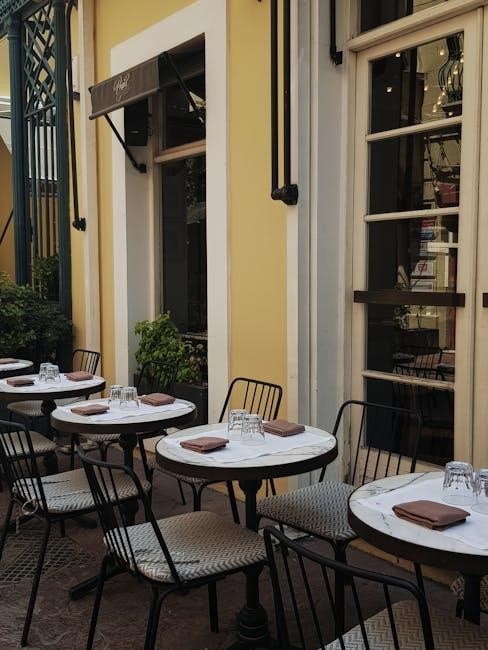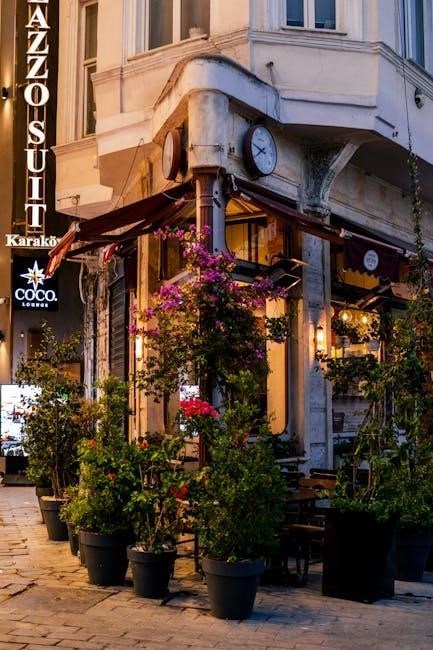This guide helps parents assess the suitability of the film Lincoln for their children, covering themes, content, and potential concerns like violence and language, while maintaining historical context.
1.1 Overview of the Guide
This guide provides a comprehensive analysis of the film Lincoln to help parents determine its suitability for their children. It examines the movies themes, content, and historical context, addressing concerns such as violence, language, and accuracy. The guide also highlights the films educational value, offering insights into leadership, morality, and historical events. By evaluating the films mature themes and content, parents can make informed decisions about whether it is appropriate for their children. The guide serves as a resource for fostering meaningful discussions and ensuring a deeper understanding of the films complex subject matter.
1.2 Importance of the Guide for Parents
This guide is essential for parents seeking to make informed decisions about their children’s media consumption. It offers detailed insights into the film Lincoln, helping parents understand its themes, content, and historical context. By highlighting potential concerns such as violence, language, and mature themes, the guide enables parents to assess whether the film aligns with their child’s sensitivity and maturity level. Additionally, it serves as a tool for fostering meaningful discussions about history, leadership, and morality. The guide ensures parents are well-equipped to guide their children through the films complex subject matter, making it a valuable resource for both education and family viewing experiences.
Movie Overview
The 2012 film Lincoln, directed by Steven Spielberg, stars Daniel Day-Lewis as President Abraham Lincoln, focusing on his efforts to pass the 13th Amendment during the Civil War.
2.1 Plot Summary of Lincoln
The film Lincoln focuses on the final four months of President Abraham Lincoln’s life, detailing his efforts to pass the 13th Amendment to abolish slavery. Set during the Civil War, the movie explores Lincoln’s political strategies, personal struggles, and his commitment to unity. It highlights his leadership as he navigates the complexities of Congress, balancing moral convictions with pragmatic compromises. The story also delves into Lincoln’s emotional depth, showing his grief over personal losses and his resolve to end the war. Directed by Steven Spielberg, the film stars Daniel Day-Lewis, who brings depth and nuance to the iconic leader. The plot emphasizes Lincoln’s determination to ensure freedom and equality, making it a powerful historical drama.
2.2 Historical Context of the Film
The film Lincoln is set during the final months of the American Civil War, focusing on President Abraham Lincoln’s efforts to pass the 13th Amendment. This amendment aimed to abolish slavery, a central issue driving the war. The movie captures the political turmoil of the era, depicting the divided nation and the moral debates surrounding slavery. It also highlights Lincoln’s leadership during a time of profound crisis, showcasing his ability to unite the country. The film is rooted in historical events but simplifies some complexities for dramatic effect. Its portrayal of key figures and legislative battles provides a compelling glimpse into a pivotal moment in U.S. history, making it a valuable resource for understanding the era.

Themes in the Movie
The film explores themes of leadership, morality, and equality, highlighting Lincoln’s political strategies and the moral dilemmas of abolishing slavery during the Civil War era.
3.1 Political Themes and Strategies
The film delves into Lincoln’s strategic brilliance, showcasing his mastery of political maneuvering to pass the 13th Amendment. It highlights the complexities of compromise, as Lincoln navigates legislative battles, balancing ideals with pragmatic deals. The movie portrays the messy reality of politics, emphasizing how alliances and negotiations shape history. Lincoln’s ability to persuade and manipulate stakeholders is central, illustrating leadership under pressure. These themes provide a rich backdrop for discussions about governance, ethics, and the challenges of enacting change. Parents can use this to explore with children how political processes work and the moral dilemmas leaders face, fostering critical thinking about democracy and power.
3.2 Moral and Ethical Dilemmas
The film explores the moral and ethical challenges Lincoln faced, particularly in balancing the human cost of war with the pursuit of freedom. It highlights his internal struggles, such as the decision to send young men to battle and the ethical implications of suspending civil liberties during the Civil War. The movie portrays Lincoln’s deep sense of responsibility and his commitment to ending slavery, even when it meant making difficult compromises. These dilemmas provide a platform for discussing complex moral issues with children, such as the justification of war, the value of human life, and the ethical sacrifices leaders must make. This can help families reflect on the moral complexities of historical decisions and their relevance today.

Historical Accuracy
Lincoln is praised for its historical accuracy, particularly in depicting the 13th Amendment’s passage and key figures like Lincoln. However, some events are simplified for storytelling purposes.
4.1 Accuracy in Depicting the 13th Amendment

The film Lincoln accurately portrays the political struggles surrounding the 13th Amendment, emphasizing its significance in abolishing slavery. It highlights Lincoln’s strategic efforts to secure votes, showcasing the complexities of legislative negotiations. While the movie condenses timelines and simplifies certain historical details for dramatic effect, it remains faithful to the core events and principles of the amendment’s passage. The portrayal of key political figures and their roles aligns with historical records, providing a realistic glimpse into the era’s challenges. Parents can trust the film’s depiction of this pivotal moment in American history, making it a valuable educational resource for understanding the fight for equality and freedom.
4.2 Portrayal of Abraham Lincoln and Key Figures

Daniel Day-Lewis delivers a compelling portrayal of Abraham Lincoln, capturing his leadership, empathy, and political acumen. The film accurately depicts Lincoln’s commitment to abolishing slavery and his strategic brilliance in navigating political challenges. Supporting characters, such as Mary Todd Lincoln and Secretary of State William Seward, are also portrayed with historical accuracy, reflecting their complex relationships and roles in shaping the 13th Amendment. While some artistic liberties are taken, the film remains largely faithful to the historical record, offering a nuanced and respectful representation of these figures. This authenticity enhances the films educational value, making it a reliable resource for understanding the era and its key players.
Suitability for Children
Lincoln is rated PG-13 due to mature themes, war violence, and brief strong language, making it more appropriate for older teens and adults rather than young children.
5.1 Age Recommendations
The film Lincoln is rated PG-13, making it suitable for older teenagers and adults. While it contains minimal gore, the intense war scenes and brief strong language may not be appropriate for younger children. The movie’s themes of political strategy and moral dilemmas are complex, requiring a level of maturity to fully understand. Parents are advised to use discretion, especially for sensitive children. The film is recommended for high school students due to its historical and educational value, but younger audiences may find the content overwhelming. It is not suitable for children under the age of 13 without parental guidance.
5.2 Content Warnings for Younger Audiences
Parents should be cautious about younger children watching Lincoln due to its mature themes and content. The film includes scenes of war violence, with images of soldiers suffering injuries and the aftermath of battles, which may be disturbing for sensitive viewers. While the gore is minimal, the emotional impact of these scenes can be intense. Additionally, there are brief instances of strong language, which, while historically accurate, may concern some parents. The film also explores complex moral and political dilemmas that younger audiences may find challenging to process. Discretion is advised for children under 13, as the content may require guidance to help them understand the context and themes.

Violence and Graphic Content
The film depicts war-related violence with minimal gore, showing soldiers with injuries and battle aftermaths, which may disturb sensitive viewers despite its historical context and emotional weight.
6.1 Depiction of War and Violence
The film portrays war-related violence with minimal gore, showing soldiers with injuries and battle aftermaths. While not excessively graphic, scenes like a soldier being gored and disemboweled may disturb sensitive viewers. The violence emphasizes the brutality of war and its human cost, rather than glorifying it. Parents should consider their child’s sensitivity to such imagery, as the film’s historical context and emotional weight may still make these scenes unsettling for younger audiences. The depiction of violence is realistic but not gratuitous, serving to underscore the sacrifices and horrors of the Civil War. This aspect of the film is crucial for understanding its historical significance but warrants parental discretion.
6.2 Emotional Impact of Violent Scenes
The film’s depiction of war and violence carries a significant emotional weight, particularly in scenes showing the aftermath of battles and the human cost of conflict. While the violence is not overly graphic, it is realistic and may evoke strong emotions in younger or sensitive viewers. The emotional impact is heightened by the historical context, as the film underscores the brutality and sacrifices of the Civil War. Parents should be prepared to discuss these scenes with their children, as they may provoke questions or concerns about the nature of war and its consequences. The film’s thoughtful portrayal encourages reflection on the emotional toll of historical events, making it important for parents to guide their children’s understanding of these intense moments.

Language and Profanity
Lincoln is rated PG-13 for brief strong language, including a few instances of profanity. The film reflects the era’s language, used to convey political intensity and realism, but remains restrained and historically contextualized.
7.1 Use of Strong Language
The film Lincoln contains brief instances of strong language, including a few uses of the f-word and mild profanity. These moments are sparse and serve to reflect the intensity of political debates and the historical context of the 1860s. While the language is not excessive, it may concern some parents. The film’s PG-13 rating accounts for these instances, which are integral to the characters’ portrayals and the era’s authenticity. Parents should consider their child’s sensitivity to such language before viewing. The strong language is not gratuitous but rather used to emphasize the emotional and political tensions of the time. This aspect of the film aligns with its historical accuracy and mature themes.

7.2 Historical Context of Language
The language in Lincoln reflects the social norms and communication styles of the 1860s, adding authenticity to the film. The dialogue mirrors the era’s formality and regional accents, with characters using period-appropriate expressions. While some words may seem offensive or outdated today, they were common during the Civil War era. The film avoids modern slang, ensuring a historically accurate portrayal. This attention to linguistic detail helps immerse viewers in the time period, making the story more believable. Parents can use this as an opportunity to discuss how language evolves and the importance of understanding historical context when interpreting older speech patterns. The film’s language is a deliberate choice to enhance its historical credibility.

Educational Value
Lincoln offers a rich learning experience, providing insights into American history, political processes, and moral leadership, making it a valuable tool for educating older students about key historical events.
8.1 Historical Learning Opportunities
The film Lincoln provides a detailed portrayal of the Civil War era and the passage of the 13th Amendment, offering students a vivid understanding of this pivotal moment in American history. It highlights the complexities of political negotiations, the moral struggles surrounding slavery, and the leadership challenges faced by Abraham Lincoln. The movie serves as an educational tool, allowing viewers to explore the legislative process, the human cost of war, and the societal transformations of the time. By depicting historical events with accuracy, Lincoln encourages critical thinking about the past and its relevance to modern democracy, making it a valuable resource for historical learning.
8.2 Lessons on Leadership and Morality
The film Lincoln offers profound lessons on leadership and morality, particularly through Abraham Lincoln’s strategic brilliance and ethical resolve. His commitment to abolishing slavery, despite political and personal challenges, underscores the importance of standing by principles. The movie highlights Lincoln’s ability to navigate complex moral dilemmas, such as balancing the pursuit of freedom with the harsh realities of war. These themes provide a rich foundation for discussions about leadership qualities like empathy, resilience, and the courage to make difficult decisions. The film also explores the moral complexities of compromise, teaching viewers that achieving great change often requires sacrifice and perseverance. These lessons inspire reflection on the importance of moral integrity in shaping a just society.
Parental Guidance and Discussion
This guide encourages parents to engage in meaningful conversations about Lincoln, fostering critical thinking and empathy while addressing complex themes and sensitive scenes in the film.
9.1 Encouraging Critical Thinking
Parents can use Lincoln to foster critical thinking by discussing its complex themes, such as political strategies and moral dilemmas. Encourage children to analyze Lincoln’s decisions, like compromising for the greater good, and reflect on the ethical implications of war. Ask open-ended questions about the film’s portrayal of leadership and its relevance to modern issues. This helps children develop analytical skills and understand historical context. Guide them to evaluate the film’s accuracy and its dramatic interpretations, promoting a deeper engagement with history and its lessons. Such discussions can inspire young viewers to think critically about the past and its impact on the present.
9.2 Handling Sensitive or Complex Scenes
Parents should prepare children for Lincoln’s sensitive scenes, such as depictions of war violence and emotional struggles. Discuss the historical context of these moments to help kids understand their significance. For example, explain how the Civil War’s brutality reflects the era’s harsh realities. When Lincoln faces moral dilemmas, guide your child in reflecting on the difficult choices leaders must make. Encourage empathy by highlighting the human cost of war, such as the death of Lincoln’s son or the suffering of soldiers. Use these scenes as opportunities to teach critical thinking and emotional intelligence, helping your child process complex emotions and historical events. Open dialogue can make these moments educational and meaningful.
The Lincoln Parents Guide aids families in making informed viewing decisions, emphasizing the film’s educational value and the importance of post-viewing discussions to enhance understanding and empathy.
10.1 Final Thoughts on the Movie

Lincoln is a powerful and thought-provoking film that offers a compelling look at a pivotal moment in American history. With strong performances and historical accuracy, it educates and inspires, making it a valuable resource for families. While its mature themes and some violent scenes may require parental discretion, the film provides a rich opportunity for discussions about leadership, morality, and equality. Parents are encouraged to watch with older children, using the movie as a tool to explore complex historical and ethical issues. Overall, Lincoln is a cinematic masterpiece that balances education and entertainment, making it a worthwhile experience for mature audiences.
10.2 Recommendations for Family Viewing
For family viewing, Lincoln is best suited for older children and teenagers due to its mature themes and historical complexity. Parents should preview the film to assess its suitability based on their child’s sensitivity to violence and complex dialogue. The movie’s educational value makes it an excellent choice for teens interested in history, offering insights into leadership, morality, and the fight for equality. Encourage post-viewing discussions to help younger audiences understand the historical context and ethical dilemmas portrayed. While not appropriate for younger children, Lincoln can be a meaningful and enriching experience for families with mature teenagers, fostering critical thinking and empathy.






























